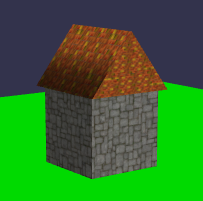Getting Started - Chapter 2 - Texture
Add Texture
In order to add color and texture to our meshes we apply a material to them. The basic material is the standard material created like this
const material = new BABYLON.StandardMaterial("name", scene);Let's make the ground color green for grass
const groundMat = new BABYLON.StandardMaterial("groundMat");groundMat.diffuseColor = new BABYLON.Color3(0, 1, 0);ground.material = groundMat; //Place the material property of the groundSince there is only one scene we can drop that parameter and let it default to the current scene.
Setting a color requires three parameters, red, green, blue (r, g, b) each 0 - 1 inclusive (0, 0, 0) is black and (1, 1, 1) is white.
For these colors you can use
BABYLON.Color3.Red();BABYLON.Color3.Green();BABYLON.Color3.Blue();BABYLON.Color3.Black();BABYLON.Color3.White();BABYLON.Color3.Purple();BABYLON.Color3.Magenta();BABYLON.Color3.Yellow();BABYLON.Color3.Gray();BABYLON.Color3.Teal();Now some texture for the box and roof
const roofMat = new BABYLON.StandardMaterial("roofMat");roofMat.diffuseTexture = new BABYLON.Texture("https://assets.babylonjs.com/environments/roof.jpg", scene);const boxMat = new BABYLON.StandardMaterial("boxMat");boxMat.diffuseTexture = new BABYLON.Texture("https://www.babylonjs-playground.com/textures/floor.png");The first parameter for a texture is a relative or absolute url to the image to be used. As usual the scene parameter is optional and will default to the current scene.
Finally of course set their material properties
roof.material = roofMat;box.material = boxMat;
Having stone walls with no doors or windows is not an interesting look for a house. Also when you look closely you can see that each side uses the same image and on some sides it is rotated.
